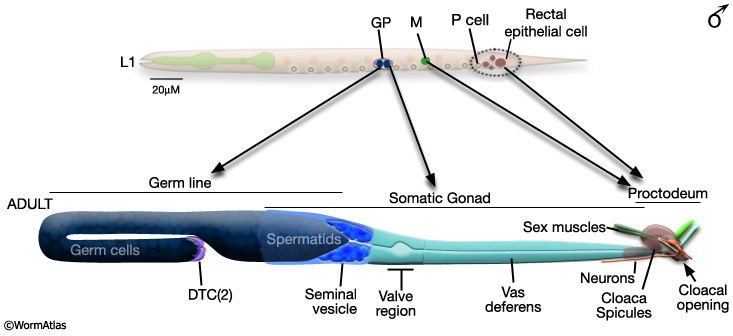1 General Information
The male reproductive system differs from that of the hermaphrodite both in the nature of gametes it produces and the somatic tissues associated with it (MaleReproFig 1). By analogy with the hermaphrodite reproductive system, we define the male reproductive system as including all those tissues directly involved in the production of gametes or their transfer during copulation: (1) the somatic gonad and neurons that innervate it (Male Reproductive System - Somatic Gonad) (2) the germ line (Male Reproductive System - Germ Line ) and (3) the proctodeum (male posterior gut) and associated neurons and muscles (described in detail in Male Reproductive System - Proctodeum). The male germ line generates only male gametes (sperm) and does so for the entire life of the animal (Klass et al., 1976). The germ line is only partially covered by the somatic gonad; both the gonad and germ line are ensheathed in a gonadal basal lamina. Together the germ line and somatic gonad form a single J-shaped arm that connects proximally to the cloaca (rectal epithelial tube) of the proctodeum. The cloaca opens to the exterior at the ventral posterior via the anus (cloacal opening). During copulation the spicules, housed inside the cloaca, probe for the vulval opening and insert into the vulva fully so that the cloacal opening is closely opposed to the vulva (see MaleSpicMOVIE 1). Behavior of the spicule is regulated by neurons (see Male Epithelial System - Spicules) and muscles associated with the proctodeum (see Male-Specific Muscles). Full spicule insertion triggers sperm release from the gonad and transfer (the process of ejaculation).
 As in the hermaphrodite, the various components of the male reproductive system have diverse lineal origins. They originate from cells that are present in both sexes at hatching but that execute different lineages or have different fates in each sex (MaleReproFig 1). The somatic gonad and germ line develop from the same 4-celled gonadal primordium (GP) as its counterparts in the hermaphrodite. Cells of the cloaca, spicule channels and spicules are generated by the rectal epithelial cells B, Y, F, U, K and neuroblast P12. In the hermaphrodite most rectal cells do not divide and instead form the hermaphrodite rectum, which is not part of the reproductive system. Most of the muscles associated with the proctodeum are derived from muscle myoblast M, which is the source of an entirely different complement of sex muscles in the hermaphrodite. Neurons that innervate the male somatic gonad and the proctodeum are derived from B and Y (Klass et al., 1976; Sulston and Horvitz, 1977; Kimble and Hirsh, 1979; Sulston et al., 1980; Hodgkin, 1988; The Male Wiring Project).
|
2 References
Hodgkin, J. 1988. Sexual dimorphism and sex determination. In The nematode C. elegans (ed. W.B. Wood). Chap. 9. pp 243-279. Cold Spring Harbor Laboratory Press, Cold Spring Harbor, New York. Abstract
Kimble, J. and Hirsh, D. 1979. The postembryonic cell lineages of the hermaphrodite and male gonads in Caenorhabditis elegans. Dev. Biol. 70: 396-417. Article
Klass, M., Wolf, N. and Hirsh, D. 1976. Development of the male reproductive system and sexual transformation in the nematode C. elegans. Dev. Biol. 52: 1-18. Abstract
Sulston, J.E. and Horvitz, H. R. 1977. Post-embryonic cell lineages of the nematode Caenorhabditis elegans. Dev. Biol. 56: 110-156. Article
Sulston, J.E., Albertson, D.G. and Thomson, J.N. 1980. The Caenorhabditis elegans male: Postembryonic development of nongonadal structures. Dev Biol. 78: 542-576. Article
Sulston, J.E., Schierenberg, E., White J.G. and Thomson, J.N. 1983. The embryonic cell lineage of the nematode Caenorhabditis elegans. Dev. Biol. 100: 64-119. Article
|

This chapter should be cited as: Lints, R. and Hall, D.H. 2009. Male reproductive system, general description. In WormAtlas. doi:10.3908/wormatlas.2.14
Edited for the web by Laura A. Herndon. Last revision: July 22, 2013. |